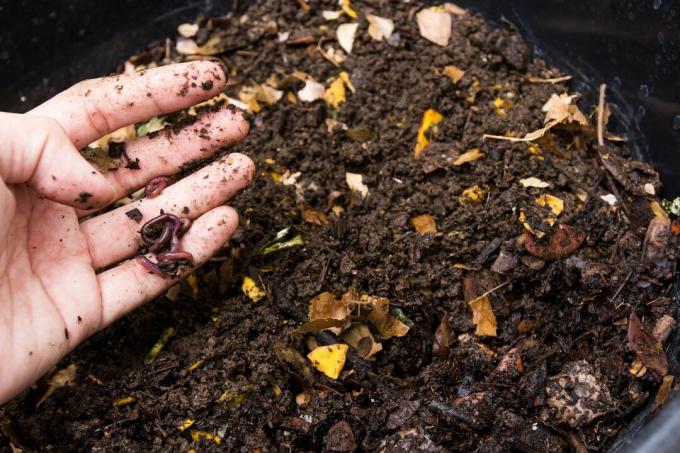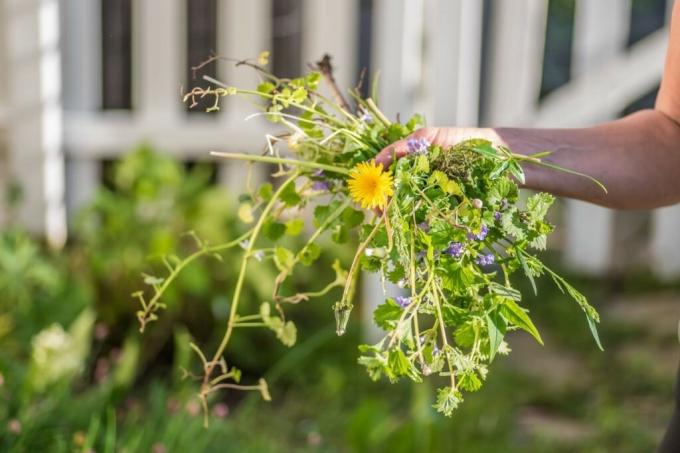Composting mistakes often concern ventilation or incorrect composting. We show the five most common composting problems and how to get around them.

The own compost is a piece of independence. But quite a few compost heaps are moldy, disgruntled, because something fundamentally goes wrong with their operation. We'll tell you about the most common mistakes when composting.
Composting is a multi-step process in which microorganisms of all kinds, such as bacteria, fungi, insects and worms, are involved. The living conditions of this very diverse group of organisms determine whether, how and how well composting takes place. Factors such as temperature, pH and the ratio of carbon compounds to nitrogen compounds influence the activity of the little helpers. We have summarized the five most important cornerstones of successful composting so that you don't make the following mistakes.
contents
- 1. Compost too dry or too moist
- 2. Compost poorly ventilated
- 3. Compost too low or too rich in nutrients
- 4. Mistake in composting: lack of beneficial organisms
- 5. Use of the wrong compost
1. Compost too dry or too moist
Like us humans, the organisms involved in composting largely consist of water and can only survive and reproduce diligently in a sufficiently moist environment. In addition, water is needed to dissolve, soften organic structures and transport nutrients. If the rotting material - i.e. the living space of the organisms - is too dry, all composting processes run very slowly or not at all. But even the opposite extreme is not an advantage and can be a mistake when composting: A too wet one Pile contains too little oxygen for the aerobic (air-breathing) microorganisms that make up the majority of small beneficial insects turn off. In this case too, they have difficulty effectively promoting composting. To ensure that your compost is not too dry or too wet, you should consider the following points:
- A composter should be in a partially shaded, sheltered location
- A composter must be open at the bottom, water must be able to drain off unhindered
- The compost material must be protected from drying out by a cover
- In very dry, hot periods, a compost should be watered occasionally

2. Compost poorly ventilated
Not only too much water in the rotting material causes a lack of oxygen in the compost heap. The type of material to be composted also affects ventilation. If a lot of fine, moist and easily decomposable material is piled up, it soon collapses, Trapped oxygen is breathed in, creating real "dead zones" for aerobes Microorganisms. Therefore, regular shifting or a careful alternation of fine with coarse material is an extremely important factor in order to avoid mistakes in composting.
3. Compost too low or too rich in nutrients
Different organic materials have different levels of stability: nutrient-rich, soft material is easily broken down, but nutrient-poor, stable material is hardly suitable for microorganisms crack. If only very stable, decomposition-resistant material ends up on a compost heap, its decomposition is very much inhibited. In this case, you should use a universal fertilizer like ours Plantura organic universal fertilizer to be helped a little. Conversely, with exclusively soft, nutrient-rich material, any structures are immediately broken down and mineralized into nutrients. However, there is hardly any material left for the build-up of humus molecules, and the compost loses a lot of volume. The end product is extremely nutritious and should be used as a fertilizer rather than a soil conditioner. So a mixture of stable, nutrient-poor material and soft, nutrient-rich material is optimal.
4. Mistake in composting: lack of beneficial organisms
Without composting organisms, there will be no composting. In the following ways the unhelpful can get into your compost:
- The composter stands on open, vital ground from which organisms migrate
- The compost is "inoculated" with the compost of a run-in heap
- A “compost starter” with permanent forms of living microorganisms is used
5. Use of the wrong compost
Another mistake in composting is using the wrong material. It should be very clear that only organic material belongs on a compost. Glass, metals, plastic or other man-made materials cannot be composted. Cooked foods, especially leftover meat and dairy products, do not belong in the composter. They attract rats or raccoons or are colonized by unwanted guests such as maggots and fly larvae.

Because the shells of raw eggs can be contaminated with salmonella, these too should be excluded from composting. And to save yourself a lot of hassle, keep root and seed weeds away from the compost heap as well. When these germinate or continue to grow in and on the pile, they spread unwanted wild herbs throughout the garden via the compost.
If you are in detail with the subject Composting want to keep busy, you will find our compost overview article here, which will guide you on all special topics.
